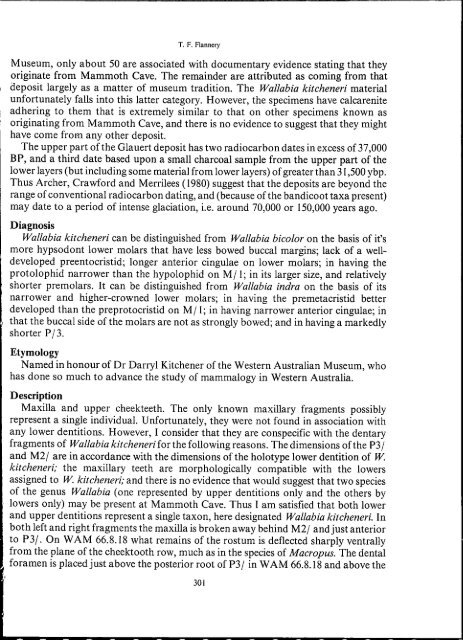a new species of wallabia - Western Australian Museum
a new species of wallabia - Western Australian Museum
a new species of wallabia - Western Australian Museum
Create successful ePaper yourself
Turn your PDF publications into a flip-book with our unique Google optimized e-Paper software.
T. F. Flannery<br />
<strong>Museum</strong>, only about 50 are associated with documentary evidence stating that they<br />
originate from Mammoth Cave. The remainder are attributed as coming from that<br />
deposit largely as a matter <strong>of</strong> museum tradition. The Wallabia kitcheneri material<br />
unfortunately falls into this latter category. However, the specimens have calcarenite<br />
adhering to them that is extremely similar to that on other specimens known as<br />
originating from Mammoth Cave, and there is no evidence to suggest that they might<br />
have come from any other deposit.<br />
The upper part <strong>of</strong>the Glauert deposit has two radiocarbon dates in excess <strong>of</strong> 37,000<br />
BP, and a third date based upon a small charcoal sample from the upper part <strong>of</strong> the<br />
lower layers (but including some material from lower layers) <strong>of</strong>greater than 31,500 ybp.<br />
Thus Archer, Crawford and Merrilees (1980) suggest that the deposits are beyond the<br />
range <strong>of</strong>conventional radiocarbon dating, and (because <strong>of</strong>the bandicoot taxa present)<br />
may date to a period <strong>of</strong> intense glaciation, i.e. around 70,000 or 150,000 years ago.<br />
Diagnosis<br />
Wallabia kitcheneri can be distinguished from Wallabia bicolor on the basis <strong>of</strong> it's<br />
more hypsodont lower molars that have less bowed buccal margins; lack <strong>of</strong> a welldeveloped<br />
preentocristid; longer anterior cingulae on lower molars; in having the<br />
protolophid narrower than the hypolophid on M/ 1; in its larger size, and relatively<br />
shorter premolars. It can be distinguished from Wallabia indra on the basis <strong>of</strong> its<br />
narrower and higher-crowned lower molars; in having the premetacristid better<br />
developed than the preprotocristid on M/ 1; in having narrower anterior cingulae; in<br />
that the buccal side <strong>of</strong> the molars are not as strongly bowed; and in having a markedly<br />
shorter P/3.<br />
Etymology<br />
Named in honour <strong>of</strong> Dr Darryl Kitchener <strong>of</strong>the <strong>Western</strong> <strong>Australian</strong> <strong>Museum</strong>, who<br />
has done so much to advance the study <strong>of</strong> mammalogy in <strong>Western</strong> Australia.<br />
Description<br />
Maxilla and upper cheekteeth. The only known maxillary fragments possibly<br />
represent a single individual. Unfortunately, they were not found in association with<br />
any lower dentitions. However, I consider that they are conspecific with the dentary<br />
fragments <strong>of</strong> Wallabia kitcheneri for the following reasons. The dimensions <strong>of</strong>the P3/<br />
and M2/ are in accordance with the dimensions <strong>of</strong> the holotype lower dentition <strong>of</strong> W.<br />
kitcheneri; the maxillary teeth are morphologically compatible with the lowers<br />
assigned to W. kitcheneri; and there is no evidence that would suggest that two <strong>species</strong><br />
<strong>of</strong> the genus Wallabia (one represented by upper dentitions only and the others by<br />
lowers only) may be present at Mammoth Cave. Thus I am satisfied that both lower<br />
and upper dentitions represent a single taxon, here designated Wallabia kitcheneri. In<br />
both left and right fragments the maxilla is broken away behind M2/ and just anterior<br />
to P3/. On WAM 66.8.18 what remains <strong>of</strong> the rostum is deflected sharply ventrally<br />
from the plane <strong>of</strong>the cheektooth row, much as in the <strong>species</strong> <strong>of</strong> Macropus. The dental<br />
foramen is placed just above the posterior root <strong>of</strong> P3/ in WAM 66.8.18 and above the<br />
301
















